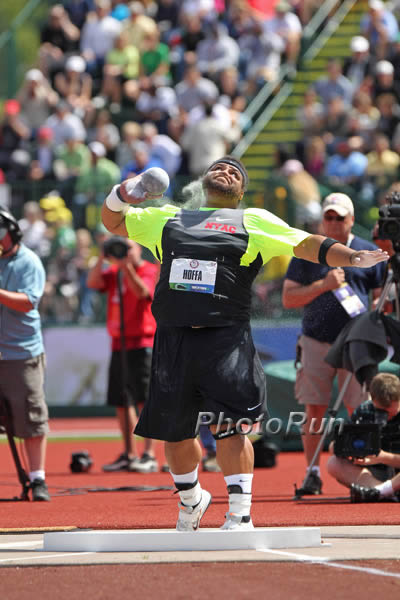Jon Gugala has had a journalist breakthrough. His column today is about the ability to appreciate the athleticism and work of the field eventers, sprinters and jumpers, when one, perhaps, is ensconced in the world of middle and long distances. We are so proud!
By Jon Gugala
EUGENE, Oregon
June 25, 2012
It takes a skinny man to admit he doesn’t know doodily-squat about the shot put.
So went my day three of the 2012 U.S. Olympic team trials: applause, smiles, and holding my voice recorder up amid a gaggle of reporters to catch the words of athletes living the best day of their last four years–all without a lot of background information.
Myopically covering the sport of mid-distance and distance running leaves you ill-prepared to cover days of the trials where there are not mid-distance or distance events. Sunday, the lay-day before the men and women’s 800-meter finals and the start of the 5,000-meter rounds and steeplechase heats (an example of biased phrasing right there), three world-leading marks were set, including the men’s shot put and men and women’s 400-meters. Twenty-one athletes made their Olympic dreams a reality.
But for a distance running journalist, Sunday was epitome of herd mentality: “Oh, all the other journalists are running over there? I guess I’d better go, too.” New-made Olympians were like car wrecks I slowed down to rubberneck at.
Sanya Richards-Ross, the 2008 Olympic bronze-medalist in the 400-meter run, dominated her event final as she qualified for her third consecutive Olympics–that much was apparent. You don’t go tying an Olympic trials record (her heat-winning 49.28 seconds) without having a certain mastery of your respective event. Excellence is obvious.
LaShawn Merritt, who spent some time away from the track after an embarrassing incident with a male-enhancement product, returned to defend his 2008 trials 400-meter title with a world-leading time of 44.12.
Even Reese Hoffa, the 2008 trials shot put champion, who this year flung a 16-pound metal ball (I literally cannot remember the last time I did anything exercise-related with something that heavy) through the air 72 feet, 2.25 inches (22.00 meters)–the farthest in the world this year–is someone that you find yourself standing in awe of.
Picking up my media credentials a few days back–before he entered competition in his fourteenth-straight national championship–I had the chance to observe Hoffa. He was wearing shorts, and the man’s calves from behind looked as round and tight as apples–big apples with mean-looking veins.
However, with my limited knowledge, coverage of the shot put sounded something like this: “Men throwing things for the next two hours.”
Also, “They are yelling really loud about it.”
We all have out preferences, which are often tied to personal experience. As a guy who gets up and out the door every day to run, mine happen to be in events that involve covering distances with your feet for the duration of longer than a minute. But after yesterday’s experience, I feel a certain guilt over my passion for one side of the sport to the exclusion of the rest.
The shot-putters walked through the mixed zone after their competition with chalk dust behind their ears and shoulders pulled back, arms trailing behind them. These are massive men, of the achetype you see unsmiling outside of a packed bar on a Friday night that remind you to maybe tone it down so that you can avoid interaction with them (no doubt uncomfortable in the extreme).
To see them competing and yelling (and not escorting you out of an establishment); well, I don’t think it’s that far of a stretch to learn a little more. It seems a better idea than trying to follow Mixed Martial Arts.
Now, don’t get me wrong; you’re not going to find me out tomorrow morning at the track practicing the loneliness of the long-distance shot-putter. I’ll still be spending my time on the fire roads of my local state park.
But a greater knowledge–whether for fan or journalist–seems well within the fraternal bonds of the sport of track and field. It’s the next stride–or throw–toward a continuity of voice necessary for the sport to garner national attention more than once every four years.





















